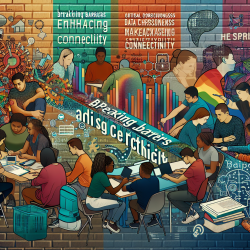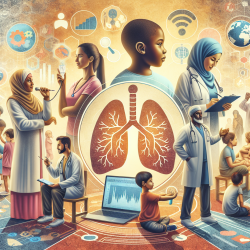Introduction
In a world where systemic oppression continues to create barriers for marginalized groups, it is crucial for practitioners to stay informed and adapt their practices to foster inclusivity and support. The recent study, "Critical Consciousness for Connectivity: Decoding Social Isolation Experienced by Latinx and LGBTQ+ Youth Using a Multi-Stakeholder Approach to Health Equity," provides valuable insights into the challenges faced by Latinx and LGBTQ+ youth and offers strategies for addressing these issues.
Understanding the Problem
The study highlights the social isolation experienced by Latinx and LGBTQ+ youth, which is often exacerbated by oppressive systems and cultural norms. This isolation can lead to significant mental and physical health disparities, including depression, substance use, and even suicidal tendencies. The research underscores the importance of recognizing intersectional identities and the role they play in social isolation.
Implementing Critical Consciousness
One of the key takeaways from the study is the application of critical consciousness theory, which encourages individuals to reflect on and challenge oppressive systems. By fostering critical consciousness, practitioners can help youth decode their experiences of social isolation and work towards creating a more inclusive and supportive environment.
- Reflect and Decode: Encourage youth to reflect on their experiences and identify the factors contributing to their isolation.
- Promote Solidarity: Facilitate discussions that build solidarity among marginalized groups, emphasizing shared experiences and mutual support.
- Action-Oriented Interventions: Develop interventions that focus on improving access to resources and creating culturally competent healthcare environments.
Creating Safe Spaces
Practitioners can play a vital role in creating safe and inclusive spaces for Latinx and LGBTQ+ youth. This involves not only addressing individual-level factors but also challenging community norms and institutional policies that perpetuate isolation. By fostering environments where youth feel seen and heard, practitioners can help mitigate the negative effects of social isolation.
Encouraging Further Research
While the study provides a solid foundation for understanding and addressing social isolation among Latinx and LGBTQ+ youth, it also highlights the need for ongoing research. Practitioners are encouraged to engage with the research community, contribute to the development of new interventions, and continuously evaluate the effectiveness of their practices.
Conclusion
By implementing the findings from this study, practitioners can enhance their skills and create more supportive environments for Latinx and LGBTQ+ youth. Embracing critical consciousness and promoting solidarity are essential steps towards achieving health equity and improving outcomes for these marginalized groups.
To read the original research paper, please follow this link: Critical Consciousness for Connectivity: Decoding Social Isolation Experienced by Latinx and LGBTQ+ Youth Using a Multi-Stakeholder Approach to Health Equity.










